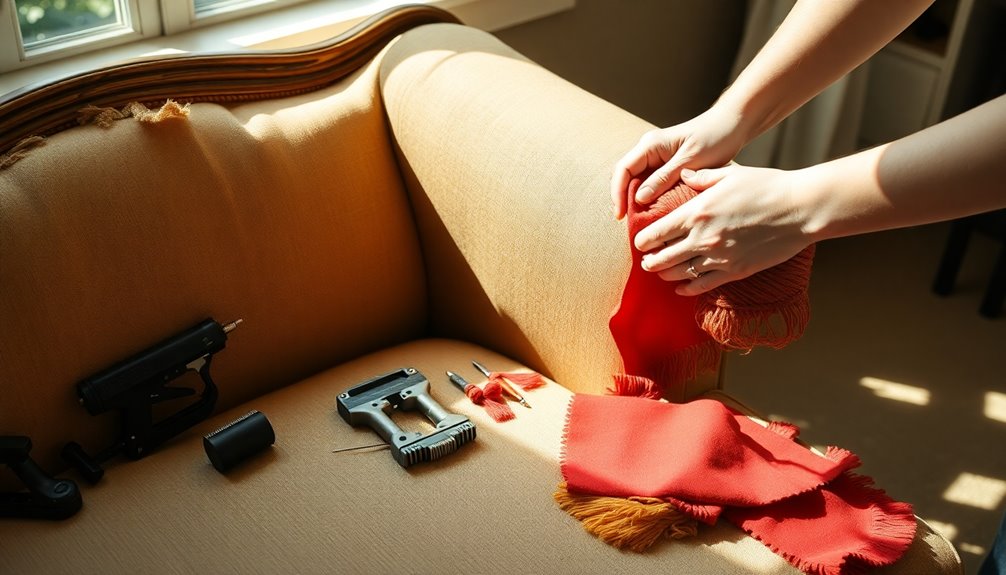To take apart your sofa, first gather tools such as screwdrivers and an adjustable wrench. Make sure to clear the area for safety and better access. Then, carefully remove cushions and upholstery to avoid damaging the fabric. Identify and remove all fasteners, such as screws and bolts, section by section. Start with the legs, as they are usually easier to detach. Once the frame is accessible, begin dismantling it one piece at a time. Keep all parts organized in labeled bags for easy reassembly in the future. You will discover more tips on handling this task efficiently as you go along.
Key Takeaways
- Gather essential tools like screwdrivers, an adjustable wrench, and an Allen wrench for efficient disassembly.
- Remove cushions and upholstery carefully, taking note of hidden fasteners to avoid damage.
- Identify and systematically remove fasteners, keeping them organized in labeled bags for easy reassembly.
- Disassemble the frame section by section, starting with legs for simplicity and safety.
- Wrap and label all parts for protection and easy transport, ensuring proper organization throughout the process.
Gather Necessary Tools
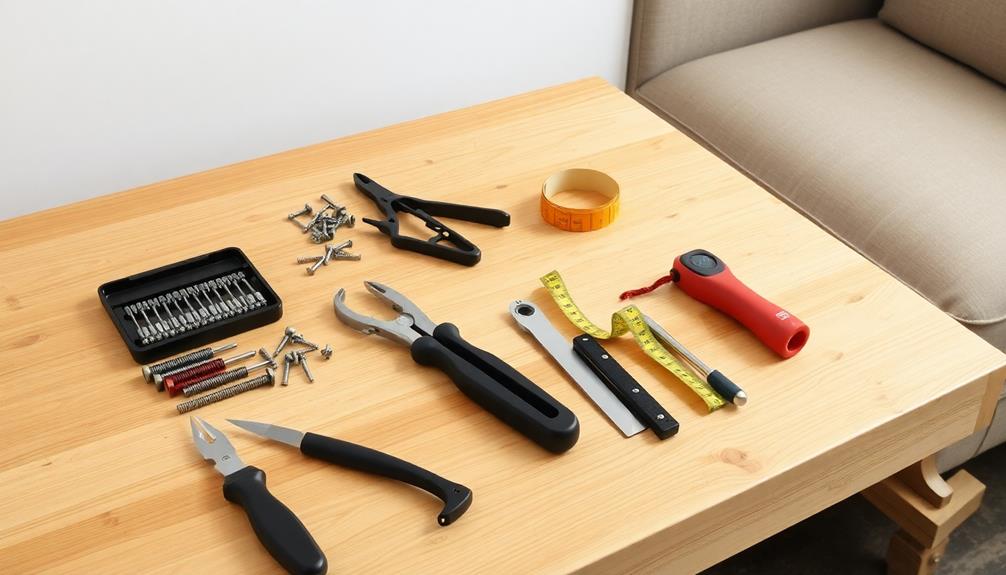
Before you plunge into disassembling your sofa, it's important to gather the necessary tools. Start with a screwdriver set that includes both Phillips and flathead screwdrivers in various sizes. This variety will help you tackle different screw types typically found in sofas.
Additionally, consider having a cleaning solution handy for any dust or debris you may encounter, as maintaining a clean workspace can improve your efficiency and focus while working on your project. Next, grab an adjustable wrench; this tool is essential for loosening and tightening various nuts you'll encounter during disassembly.
Don't forget to acquire an Allen wrench set as well, since hex bolts are often used in sofa construction, and having the right sizes on hand will make your work much easier.
As you remove screws and small components, prepare plastic bags or containers to organize and label them. This step will save you a lot of headaches during reassembly.
For those looking to optimize their workspace further, air quality considerations can greatly enhance your comfort while you work.
Clear the Workspace
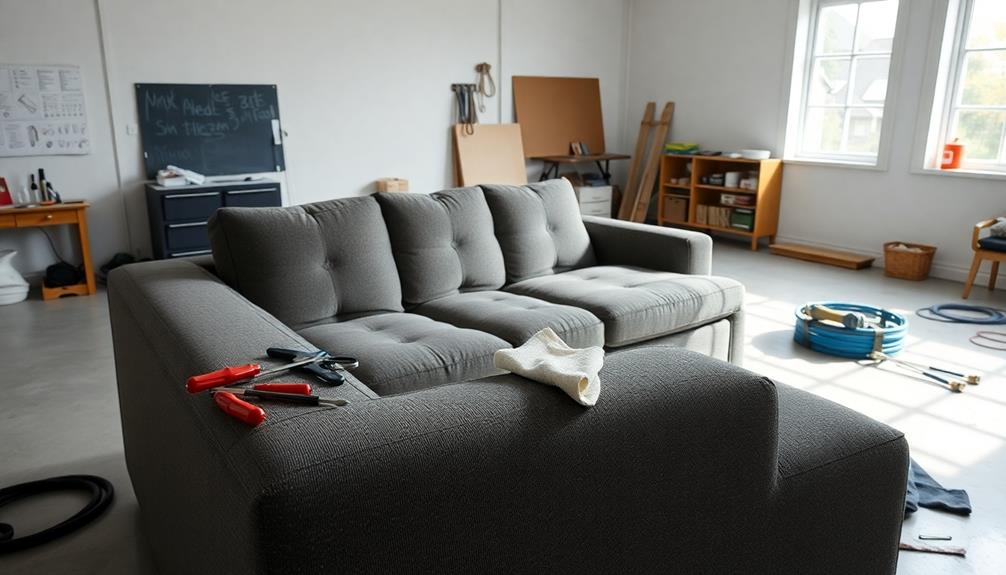
A clutter-free workspace is essential for a smooth sofa disassembly. Start by removing any old furniture, obstacles, or items that might hinder your movement around the sofa. This creates a safe environment for you to work in. Confirm the area is well-lit to prevent accidents and enhance visibility while you tackle the disassembly.
Additionally, consider organizing your tools in a way similar to how mechanic shops keep their workspaces organized to avoid any confusion during the process.
Next, prepare the floor with protective materials like cardboard or furniture sliders. This helps prevent damage during the process and makes it easier to maneuver the pieces.
Also, plan for ample room around the sofa, allowing you to access all sides comfortably. A spacious area will help you work more efficiently.
Organize your tools and materials within easy reach. Having everything you need at hand minimizes disruptions, allowing you to focus on the task at hand.
Once the workspace is clear and organized, you'll be ready to dispose of your sofa effectively. With the right preparations, furniture disposal becomes a hassle-free experience. Taking these steps will confirm that you can disassemble your sofa with ease, making the overall process smoother and more enjoyable.
Remove Cushions and Upholstery
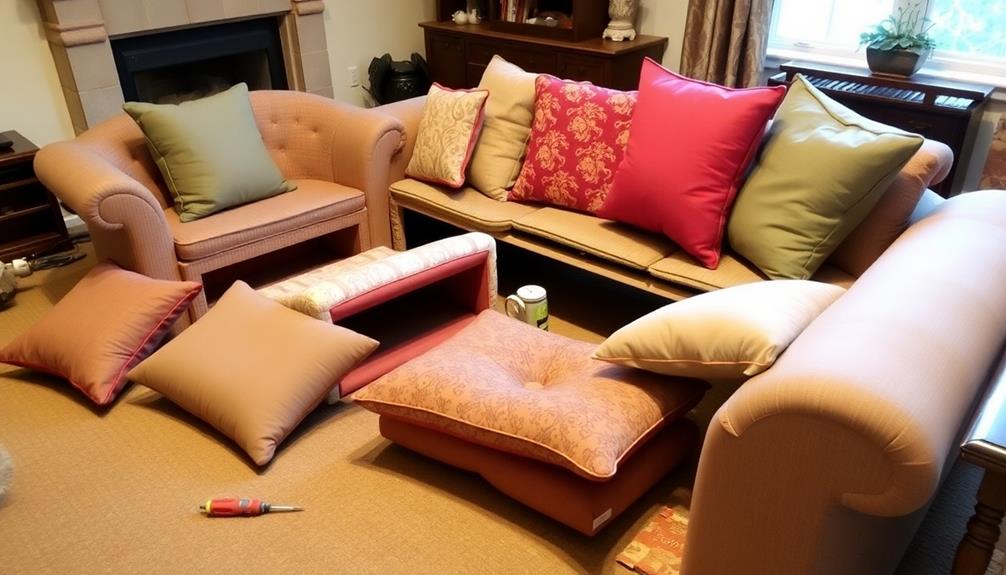
With your workspace now clear and organized, it's time to focus on removing the cushions and upholstery from the sofa. Start by taking out all loose cushions and pillows, placing them in a designated area for safe storage during the disassembly process.
If your sofa has attached cushions, grab a box cutter and carefully cut through any fabric or fasteners that hold them in place. Be gentle to minimize damage to the upholstery. This process can be made easier with the use of natural materials, like wood, for any necessary tools or support, reflecting the modern farmhouse decor trends.
Next, inspect the upholstery for hidden staples or tacks. Use a staple puller to carefully remove them if you plan to reuse the fabric. If the fabric isn't being preserved, you can cut or rip it away from the frame. Pay close attention to the seams to avoid unnecessary damage to the underlying structure.
Once the upholstery is removed, take a moment to assess the condition of any foam padding or internal materials. You might find that they're suitable for recycling or repurposing, which is a great way to reduce waste.
Identify and Remove Fasteners
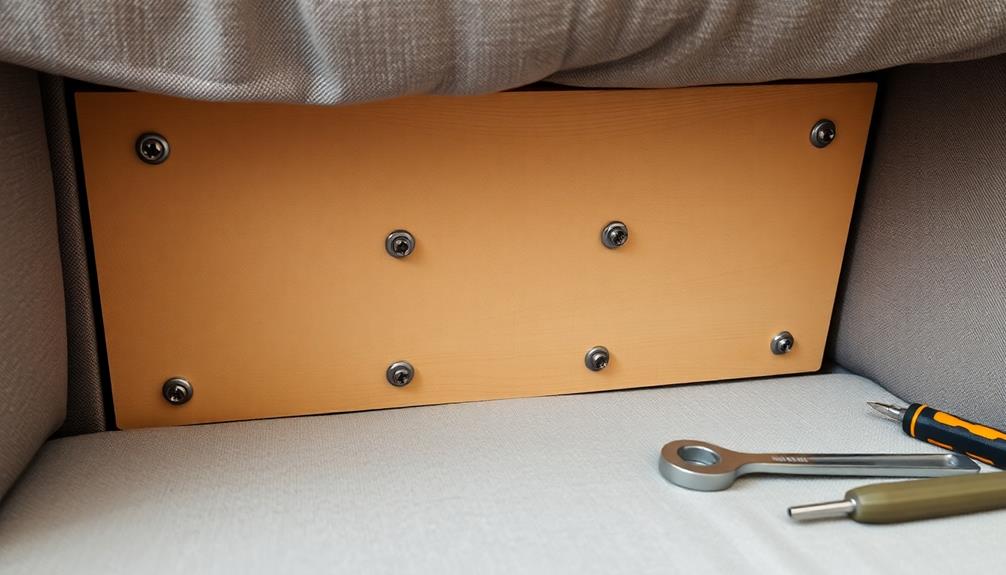
Start by identifying the different types of fasteners on your sofa, such as screws and bolts, which can often be hidden from plain sight.
Understanding the importance of having a budget for any home improvement project can also help you plan for potential costs associated with new furniture or tools.
Once you know what you're dealing with, use the right tools to carefully remove them in a systematic way, tackling one section at a time.
This method not only prevents confusion but also makes reassembly much easier later on.
Fastener Types Overview
Often overlooked, fasteners play an essential role in the construction of sofas and can vary markedly in type. Understanding these fasteners is vital for a successful disassembly. The most common fasteners you'll encounter include:
1. Screws: Typically used to secure the frame, screws come in various sizes. You'll need either a Phillips or flathead screwdriver to remove them. Be sure to choose the correct size to prevent stripping the heads.
Additionally, consider using essential oils for toothache relief to alleviate any discomfort while working.
2. Bolts: These are often used for more robust connections within the sofa. An adjustable wrench or a socket set is important for loosening and detaching bolts from the frame.
3. Staples: Commonly used to attach upholstery to the frame, staples require a bit of finesse. A staple puller or a flathead screwdriver will help you carefully remove them without damaging the upholstery or the frame.
As you work, keep all removed fasteners organized in labeled bags or containers. This will simplify reassembly and help you avoid confusion later.
With this knowledge, you're ready to tackle the disassembly process effectively.
Systematic Removal Process
To effectively disassemble your sofa, you'll want to carefully inspect the frame to identify all visible fasteners like screws and bolts.
Start by checking the joints and hidden areas to guarantee you don't miss any screws holding various components together. Using a screwdriver or adjustable wrench, systematically remove fasteners in a methodical manner, especially in areas where dust can accumulate, as this can give you insights into best vacuums for dust removal that might be useful for cleaning post-disassembly.
This will help you avoid losing track of which fasteners belong to which parts.
As you work, it's a good idea to remove the legs first, as they can often be the easiest components to detach. Place the removed screws and bolts in labeled plastic bags or containers to keep everything organized and easy to find later on.
Continue inspecting the sofa frame for any additional connections that may need attention. After you've removed all visible fasteners, take a moment to double-check that nothing's been overlooked.
This thorough approach will prevent any hiccups during the disassembly process and guarantee you're ready for the next steps.
Disassemble the Frame
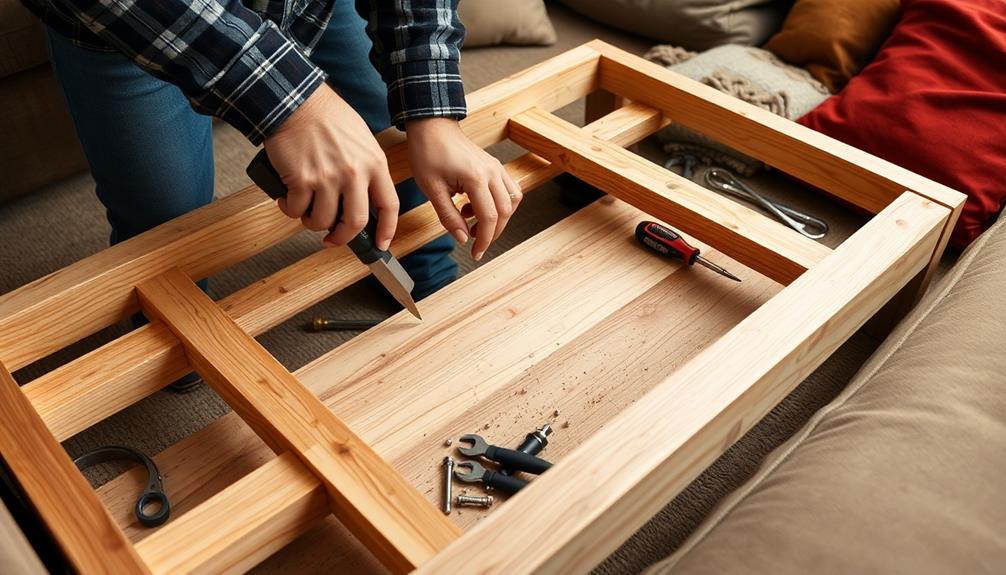
To disassemble the frame, start by flipping the sofa onto its back so you can identify the different sections.
It's important to guarantee that you have a clean and organized workspace, as this will help you keep track of the fasteners and components you remove.
You'll need to remove fasteners carefully and use the right tools to avoid damaging the frame.
Be sure to take note of any features, such as energy-efficient appliances, that may influence how you approach the disassembly process.
Keep safety in mind as you work through each part, guaranteeing you label everything for a smoother reassembly later.
Frame Section Identification
Disassembling a sofa starts with identifying its frame sections, which are essential for a smooth process.
Begin by flipping the sofa onto its back or side to access the frame. Examine the underside for visible screws and bolts that hold the frame together. You'll typically find three main sections: —the backrest, seat, and the fold-out bed mechanism if it’s a sleeper sofa. If you’re wondering *how to unfold a sofa bed*, look for the metal frame beneath the seat cushions. Gently pull on the handle or bar located at the front, and the bed should extend smoothly from the base.
- Arms: These are the side supports of the sofa, often connected with screws or brackets. Ensuring that each arm is properly detached will help maintain the integrity of the structure during disassembly.
- Seat: This part includes the base where you sit, which may be a single piece or divided into sections. It's crucial to recognize whether the seat is supported by additional cross braces, which may require extra attention during removal.
- Backrest: The vertical part that supports your back; it usually connects to the seat and arms. In addition to traditional framing, some sofas may utilize color accuracy principles in their design for aesthetic purposes.
As you identify these sections, take note of how they're connected to make reassembly easier later.
Use the appropriate tools, like a Phillips head screwdriver or Allen wrench, to methodically remove screws and bolts. Keep fasteners organized in labeled bags to avoid confusion.
Don't forget to check for hidden fasteners in joints or brackets, which may require additional tools, such as a staple puller for any remaining upholstery staples.
Label or mark all frame components for a hassle-free reassembly after transportation or refurbishment.
Fastener Removal Techniques
Once you've identified the frame sections of your sofa, the next step involves removing the fasteners that hold it all together. Start by inspecting the frame for visible screws, bolts, and other fasteners. You'll likely encounter various types, such as Phillips or hex screws.
Grab the appropriate screwdriver or Allen wrench to systematically remove each fastener. To make reassembly easier later, keep them organized in labeled bags. Additionally, make sure that you're aware of any potential risks, particularly if you're handling tools that may cause strain or discomfort—considering common cold medications for relief if needed.
For those tricky fasteners tucked away in tight spots, consider using an adjustable wrench or socket set. These tools will give you the leverage you need to access hard-to-reach areas effectively.
Don't forget to check for hidden fasteners, like staples or nails, especially around the upholstery. A staple puller or pliers can help you safely remove these without damaging the fabric.
After you've removed all visible fasteners, double-check the frame to make certain none are still attached. This thorough approach will facilitate a smooth separation of the sofa parts, setting you up for the next steps in your disassembly process.
Safe Disassembly Practices
Starting the disassembly of your sofa's frame involves a careful and methodical approach to guarantee safety and efficiency. When you take apart a sofa, it's essential to follow safe disassembly practices to avoid damaging components and guarantee a smooth reassembly later on.
Begin by removing the legs, as they're typically secured with screws that are easy to unscrew using a Phillips head screwdriver or an adjustable wrench. Additionally, it's wise to take into account the principles of regular checks and proper handling, which can also apply to furniture disassembly.
Here are three key steps to keep in mind:
- Inspect for Hidden Fasteners: Before pulling apart sections, look for any hidden fasteners or brackets that need to be unscrewed or detached.
- Work Systematically: Tackle one section at a time to maintain organization and guarantee all components are accounted for.
- Use the Right Tools: When dealing with upholstery, use a staple puller to remove staples or tacks without damaging the frame.
Always keep removed screws and fasteners organized in labeled bags. This prevents confusion and guarantees you have everything you need when it's time to reassemble.
Prepare for Transportation
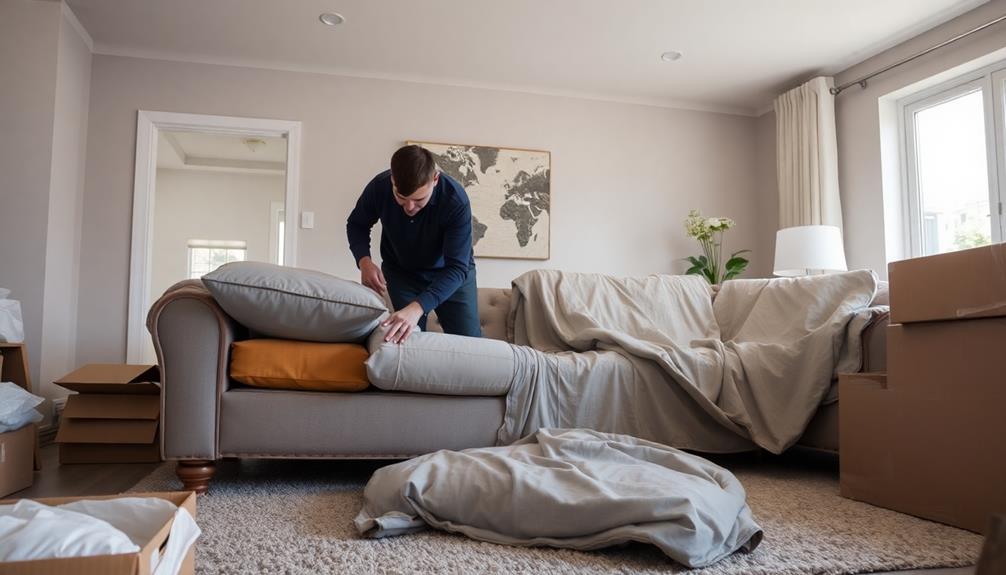
When you're ready to transport your disassembled sofa, it's crucial to protect its components to prevent any scratches or damage. Start by wrapping each piece securely with blankets or bubble wrap. This guarantees they stay safe during transit. Next, organize and label all parts, including screws and fasteners, in plastic bags or containers—this makes reassembly a breeze later.
To keep everything stable, employ zip ties or rope to bundle the wrapped components together. This prevents movement in the vehicle, which could lead to unwanted damage. When loading the parts, distribute the weight evenly to maintain balance. Secure everything to avoid shifting during transit.
Here's a quick reference table to help you prepare:
| Step | Action | Purpose |
|---|---|---|
| Wrap | Use blankets/bubble wrap | Prevent scratches/damage |
| Organize | Label bags/containers | Guarantee easy reassembly |
| Secure | Bundle with zip ties | Maintain stability in transit |
Following these steps will help you prepare for safe transportation, guaranteeing your sofa arrives at its destination in excellent condition.
Disposal and Recycling Options
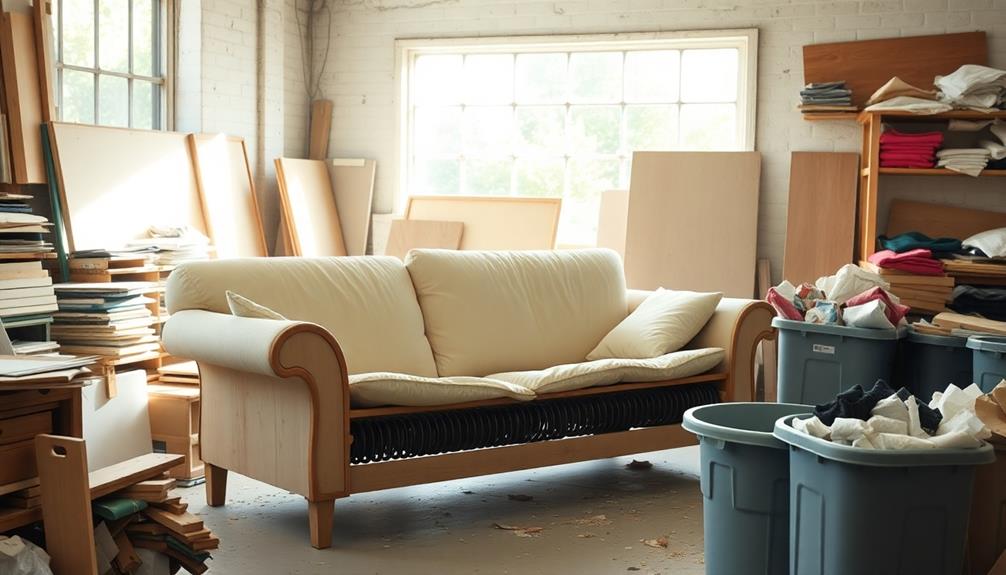
Responsible disposal and recycling of your sofa not only reflects a commitment to sustainability but also helps reduce waste in landfills. As you consider how to dispose of your old sofa, there are several options that can minimize your environmental impact.
Additionally, being mindful of financial considerations for elderly care can align with your efforts to make sustainable choices.
- Furniture Donations: If the sofa's still usable, donate it to local charities or organizations that accept furniture donations. This way, you're giving it a second life while helping someone in need.
- Recycling Center: Research local recycling programs that accept furniture components. Many recycling centers will take wood, metal, and upholstery, guaranteeing that these materials are properly recycled instead of ending up in a landfill.
- Waste Removal Services: Utilize services like 1-800-GOT-JUNK? for responsible disposal of unwanted sofa materials. They specialize in waste removal and can help you ascertain that as much of your sofa as possible is recycled or reused.
Post-Disassembly Tips
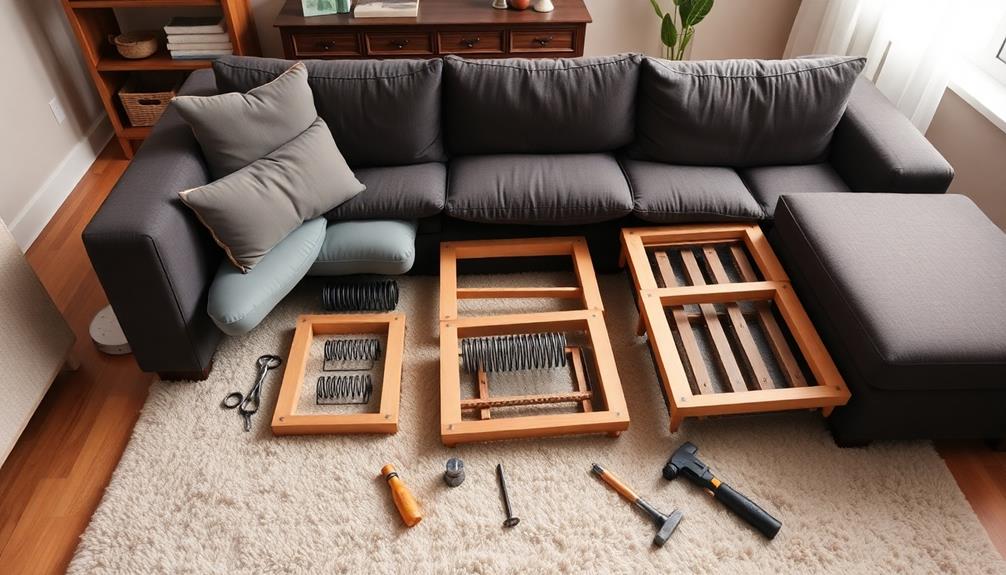
After you've disassembled your sofa, it's crucial to take a few practical steps to guarantee everything is organized and safe.
Start by thoroughly cleaning your workspace. Remove any debris or leftover materials to maintain a clean environment, which prevents accidents and guarantees you can focus on the next steps.
Next, organize the disassembled parts. Store them in a designated area, labeling each item for easy access when it's time to reassemble. This organization will save you time and frustration later.
As you sort through the materials, assess their condition. Check the upholstery and cushions for any potential reuse or recycling options.
This evaluation helps you determine what can be salvaged and what needs to be disposed of responsibly.
Frequently Asked Questions
Can Sofas Be Disassembled?
Yes, many sofas can be disassembled. You'll often find removable legs or modular sections designed for easy transport. Check for hidden fasteners and follow any included instructions for a smooth dismantling process.
How Do I Take My Couch Apart to Move?
Did you know over 70% of people struggle with moving large furniture? To take your couch apart, start by removing cushions, unscrewing legs, and carefully detaching upholstery, ensuring you keep all parts organized for reassembly. Once you’ve disassembled the main components, have a friend assist in moving the frame to avoid injury or damage to your walls. By breaking the process down into manageable steps, you can focus on moving a sofa efficiently without unnecessary frustration. Reassembling it at your new destination will be simpler if you’ve labeled the parts or taken photos during disassembly.
How to Dismantle a Sofa to Fit Through a Door?
To fit your sofa through the door, check for removable parts like arms or backs. Unscrew any fasteners, remove legs, and tilt the sections as needed to navigate the doorway easily.
How Do You Disassemble a 3 Seater Recliner Sofa?
To disassemble a 3-seater recliner sofa, lift the cushions, unscrew hidden screws, and remove the footrest. Then, tackle the armrests and finally release the locking levers to separate the sections easily.
Conclusion
Now that you've successfully disassembled your sofa, think of it as opening a treasure chest of space and potential. With the cushions gone and the frame dismantled, you've created room for new possibilities in your home. Whether you're moving, redecorating, or simply decluttering, you've taken a big step. Remember, each piece can be repurposed or recycled, turning your old sofa into a new chapter in your living space. Embrace the change and enjoy the fresh start!


